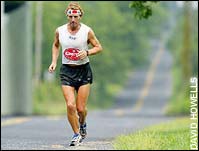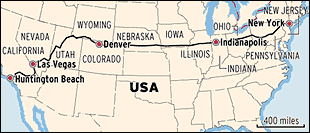- Short of a bus knocking him down, nothing can now stop
a teacher from Cornwall winning the toughest sporting contest known to
man.
-
- Bob Brown, 35, is due to cross the finishing line in
New York's Central Park today at the end of a run across America, a race
so punishing that it calls for the strength and stamina of a superman and
soles of leather instead of feet.
-
 By
the end, Mr Brown and five others who have survived the American landscape's
extremes of heat, humidity and altitude will have panted and sweated their
way almost 3,100 miles, all on foot - almost two marathons every day for
more than two months. By
the end, Mr Brown and five others who have survived the American landscape's
extremes of heat, humidity and altitude will have panted and sweated their
way almost 3,100 miles, all on foot - almost two marathons every day for
more than two months.
-
- "I don't consider myself mad," the race's runaway
leader said with less than 80 miles to go before the finish. "I think
people who lead so-called 'normal' lives are crazy because they don't chase
their dreams."
-
- The self-styled "endurance athlete" claims
never to have felt healthier and not to have suffered one blister on his
journey from the West to East Coasts. His most obvious sign of physical
wear and tear scars his face.
-
- "The biggest problem has been my lips," he
admitted, pointing to a ring of sores around his mouth. "Once you
get them burnt, there is not much you can do."
-
- His running shoes, the fifth pair so far, seem to be
falling apart but their toe sections were cut away on purpose to ensure
maximum ventilation for his feet. He has worn the same socks, washed nightly,
since the race began on June 12.
-
- A headband, a gift from a fellow runner from Japan, decorated
with a rising sun and the Japanese for "winner", gives him the
look of a Second World War Kamikaze pilot.
-
- But, apart from his wife, a British couple from Bordeaux
who act as a support crew and his sister and brother-in-law, no one cheers
him on because the race is one of the best kept secrets in the US.
-
- No spectators line the route. There is no media coverage.
And the organiser, a Briton who now lives in North Carolina, deliberately
chose as the itinerary the equivalent of B roads skirting cities to keep
the event low key.
-
- "I struggled a bit today, don't know why,"
Mr Brown said after crossing the line. "Sorry I was late." Then
he turned to his wife, Amy, and asked: "You haven't got a cold beer,
have you?" She did.
-
- Five of the original 11 starters in the race have dropped
out and the lone Briton taking part has built up an invincible lead of
more than 60 hours over his nearest rival.
-
- "The body is capable of huge feats of endurance,"
said Alan Firth, the race's organiser. "But sometimes the body wins
the incessant debate with the mind over whether to quit or not and wants
out."
-
- "I think it's his body's frame," Amy Brown
said, searching for an explanation for her husband's staying power. "It
must be quite different from others."
-
- The race across the continent has been staged only seven
times before and the physical toll it extracted from runners in the first
two contests in the 1920s earned the competitions the nickname "bunion
derbies".
-

-
- The punishment inflicted on the runners' health is on
display in their emaciated physiques.
-
- Since the off from Huntington Beach, California, Mr Brown
has lost one and a half stone, bringing his weight down to just under nine
stone.
-
- His efforts to replace the calories expended en route
are almost as heroic as his running. At one stage he was wolfing down eight
Cornish pasties a day, a gift from his main sponsor, but then ran out of
supplies.
-
- "Anything that's bad for you, that's what I eat,"
he said, checking off a list of jelly beans, crisps, energy bars and cereal
that keep him going. He hasn't touched any fruit since the race began
-
- "I gorge on chocolate," he said, sipping a
glass of red wine on the balcony of his motel room at the end of another
day. He flies home to an uncertain future, having decided to give up teaching
after only two years at Stoke Climsland school.
-
- "A person like me doesn't really fit into the education
system," he said. The course has taken runners through the blistering
heat of the Mojave Desert, over the Rocky Mountains and across the Great
Plains.
-
- The hardest slog was the climb up the Appalachian Mountains,
Mr Brown said.
-
- He is raising money for Chicks, a charity which provides
free holidays for disadvantaged children.
-
- © Copyright of Telegraph Group Limited 2004. http://www.telegraph.co.uk/news/m
ain.jhtml;sessionid=XXZSAULFQIJJ
5QFIQMFCNAGAVCBQYJVC?xml=/news/2004/08/21/wrun21.xml&sSheet=/portal/
2004/08/21/ixportal.html&secureRefresh=true&_requestid=80210
-
-
-
-
- Comment
- From Mary Sparrowdancer
- 8-22-4
-
- hmmm. Something's not quite right with this map - or
perhaps, it is my memory. This map does not seem to reflect things as
I remember them.
-
- Back in the early 1970s, I rode a bicycle from the Indiana
border of Ohio to Cape Cod, Massachusetts, and then rode the bicycle back
to New York.
-
- Back then, Ohio was not up in the Great Lakes with Michigan,
but it was located down next to Indiana. Pennsylvania spread way, way
out, right next to Ohio - it was big, big, blue-sky country, a blue like
I have never seen before - and from there I eventually found my way to
New Jersey and then New York, and upwards through Connecticut, Rhode Island
and Massachusetts. I also hit West Virginia and Delaware along the way.
-
- (I was stopped by police in Delaware, and told to back
up and go around their state, as they did not want people traveling on
bicycles in their state.) (Ok, fine.) (And, I have never forgotten this.)
-
- Regardless of where the states are now, I have to agree
with the runner, Mr. Bob Brown. I also found that crossing the Appalachian
mountains was extremely difficult. In fact, it was among the most difficult
things I think I have ever attempted in this lifetime - and I was on a
bicycle! He is on foot.
-
- There were many days when I had to sit on the asphalt
and pull my bicycle (a Raleigh packed with approximately 80 pounds of equipment)
up toward me, inches at a time. I cannot imagine trying to do a trek such
as this on foot. Since I was on a bicycle, I at least had the benefit
of making mountain descents at a rather fast pace.
-
- It is my hope that Mr. Brown achieves his goals, and
that his charity is warmly rewarded for his efforts.
-
- Having done a portion of this route by bicycle, I simply
cannot imagine the stamina needed for accomplishing this on foot. I am
in awe of his efforts. It must truly be a labor of love.
-
- mary sparrowdancer
- www.sparrowdancer.com
|

